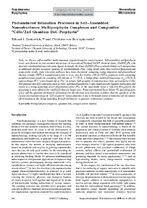Photoinduced relaxation processes in self-assembled nanostructures: multiporphyrin complexes and composites "CdSе/ZnS quantum dot-porphyrin"
Bibliographic entry
Zenkevich, E. I. Photoinduced relaxation processes in self-assembled nanostructures: multiporphyrin complexes and composites "CdSе/ZnS quantum dot-porphyrin" / E. I. Zenkevich, C. von Borczyskowski // Macroheterocycles. – 2009. – Vol. 2, № 3-4. – P. 206-220.
Abstract
Here, we discuss self-assembled multicomponent organic/inorganic nanostructures. Self-assembled multiporphyrin triads were formed via non-covalent interactions of meso-phenyl bridged ZnOEP chemical dimer, (ZnOEP)₂Ph, with dipyridyl substituted tetrapyrrole extra-ligand. In tetrads, the dimer (ZnOEP)₂Ph is covalently linked via 5-mesoposition to additional electron acceptors (quinone Q, pyromellitimide Pim). Using steady-state, time-resolved fluorescent and pump-probe results, main relaxation pathways have been elucidated: competing energy migration and photoinduced electron transfer (PET) in normal triads within ≤1.4 ps; very fast (within ~ 700 fs) PET in porphyrin triads containing pentafluorinated porphyrin remaining still efficient at 77-120 K; a bridge-dimer mediated long-range (r_DA=18-24 Å) superexchange PET "extra-ligand→Q or Pim" in tetrads. Self-assembly of nanostructures from semiconductor CdSe/ZnS quantum dots (QD) and tetra-meso-pyridyl- substituted porphyrins is also based on extra-ligation interactions and results in a strong quenching of QD photoluminescence (PL). At the same molar ratios x =[H₂P(m-Pyr)₄]/[QD], the quenching is more effective for small QDs than for larger ones. From experimental Stern-Volmer PL quenching plots I₀/I(x) and the quantum mechanical calculations for the electron wave functions it follows that the specificity of the exciton non-radiative decay in "QD-porphyrin" nanocomposites is due to the manifestation of inductive and mesomeric effects leading to the charge tunnelling through ZnS barrier in quantum confinement conditions.

